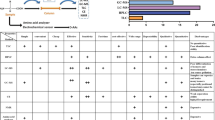Abstract
A new method was here developed for the determination of 18O-labeling ratios in metabolic oligophosphates, such as ATP, at different phosphoryl moieties (α-, β-, and γ-ATP) using sensitive and rapid electrospray ionization mass spectrometry (ESI-MS). The ESI-MS-based method for monitoring of 18O/16O exchange was validated with gas chromatography–mass spectrometry and 2D 31P NMR correlation spectroscopy, the current standard methods in labeling studies. Significant correlation was found between isotopomer selective 2D 31P NMR spectroscopy and isotopomer less selective ESI-MS method. Results demonstrate that ESI-MS provides a robust analytical platform for simultaneous determination of levels, 18O-labeling kinetics and turnover rates of α-, β-, and γ-phosphoryls in ATP molecule. Such method is advantageous for large scale dynamic phosphometabolomic profiling of metabolic networks and acquiring information on the status of probed cellular energetic system.

Monitoring of 18O enrichment in ATP at α-, β- and γ-phosphoryl moieties using ESI-MS, GC-MS, 1D and 2D 31P NMR.





Similar content being viewed by others
Abbreviations
- AA:
-
Amino acids
- FFA:
-
Free fatty acids
- G3P:
-
Glycerol 3-phosphate
- NTP:
-
Nucleoside triphosphate
References
Saks V, Dzeja P, Schlattner U, Vendelin M, Terzic A, Wallimann T (2006) Cardiac system bioenergetics: metabolic basis of the Frank–Starling law. J Physiol-London 571(2):253–273. doi:10.1113/jphysiol.2005.101444
Arrell DK, Terzic A (2010) Network systems biology for drug discovery. Clin Pharmacol Ther 88(1):120–125. doi:10.1038/Clpt.2010.91
Dzeja PP, Chung S, Faustino RS, Behfar A, Terzic A (2011) Developmental enhancement of adenylate kinase-AMPK metabolic signaling axis supports stem cell cardiac differentiation. PLoS One 6(4):10.1371/journal.pone.0019300
Dzeja PP, Bortolon R, Perez-Terzic C, Holmuhamedov EL, Terzic A (2002) Energetic communication between mitochondria and nucleus directed by catalyzed phosphotransfer. Proc Natl Acad Sci U S A 99(15):10156–10161. doi:10.1073/pnas.152259999
Dzeja PP, Hoyer K, Tian R, Zhang S, Nemutlu E, Spindler M, Ingwall JS (2011) Rearrangement of energetic and substrate utilization networks compensate for chronic myocardial creatine kinase deficiency. J Physiol-London 589(21):5193–5211. doi:10.1113/jphysiol.2011.212829
Janssen E, Terzic A, Wieringa B, Dzeja PP (2003) Impaired intracellular energetic communication in muscles from creatine kinase and adenylate kinase (M-CK/AK1) double knock-out mice. J Biol Chem 278(33):30441–30449. doi:10.1074/jbc.M303150200
Dzeja P, Terzic A (2009) Adenylate kinase and AMP signaling networks: metabolic monitoring, signal communication and body energy sensing. Int J Mol Sci 10(4):1729–1772. doi:10.3390/Ijms10041729
Janssen E, de Groof A, Wijers M, Fransen J, Dzeja PP, Terzic A, Wieringa B (2003) Adenylate kinase 1 deficiency induces molecular and structural adaptations to support muscle energy metabolism. J Biol Chem 278(15):12937–12945. doi:10.1074/jbc.M211465200
Pucar D, Dzeja PP, Bast P, Juranic N, Macura S, Terzic A (2001) Cellular energetics in the preconditioned state—protective role for phosphotransfer reactions captured by 18O-assisted 31P NMR. J Biol Chem 276(48):44812–44819
Vincent G, Khairallah M, Bouchard B, Des Rosiers C (2003) Metabolic phenotyping of the diseased rat heart using 13C-substrates and ex vivo perfusion in the working mode. Mol Cell Biochem 242(1–2):89–99
Li W, Bian F, Chaudhuri P, Mao XA, Brunengraber H, Yu X (2011) Delineation of substrate selection and anaplerosis in tricarboxylic acid cycle of the heart by 13C NMR spectroscopy and mass spectrometry. NMR Biomed 24(2):176–187. doi:10.1002/Nbm.1569
Pound KM, Sorokina N, Ballal K, Berkich DA, Fasano M, LaNoue KF, Taegtmeyer H, O'Donnell JM, Lewandowski ED (2009) Substrate-enzyme competition attenuates upregulated anaplerotic flux through malic enzyme in hypertrophied rat heart and restores triacylglyceride content attenuating upregulated anaplerosis in hypertrophy. Circ Res 104(6):805–812. doi:10.1161/Circresaha.108.189951
Kruger NJ, Ratcliffe RG (2009) Insights into plant metabolic networks from steady-state metabolic flux analysis. Biochimie 91(6):697–702. doi:10.1016/j.biochi.2009.01.004
Paul Lee WN, Wahjudi PN, Xu J, Go VL (2010) Tracer-based metabolomics: concepts and practices. Clin Biochem 43(16–17):1269–1277
Janssen E, Dzeja PP, Oerlemans F, Simonetti AW, Heerschap A, de Haan A, Rush PS, Terjung RR, Wieringa B, Terzic A (2000) Adenylate kinase 1 gene deletion disrupts muscle energetic economy despite metabolic rearrangement. EMBO J 19(23):6371–6381. doi:10.1093/emboj/19.23.6371
Griffin JL, Des Rosiers C (2009) Applications of metabolomics and proteomics to the mdx mouse model of Duchenne muscular dystrophy: lessons from downstream of the transcriptome. Genome Med 1(3):1–11
Kelleher JK (2001) Flux estimation using isotopic tracers: common ground for metabolic physiology and metabolic engineering. Metab Eng 3(2):100–110
Tang Y, Pingitore F, Mukhopadhyay A, Phan R, Hazen TC, Keasling JD (2007) Pathway confirmation and flux analysis of central metabolic pathways in Desulfovibrio vulgaris Hildenborough using gas chromatography-mass spectrometry and Fourier transform-ion cyclotron resonance mass spectrometry. J Bacteriol 189(3):940–949. doi:10.1128/Jb.00948-06
Zamboni N (2011) 13C metabolic flux analysis in complex systems. Curr Opin Biotechnol 22(1):103–108. doi:10.1016/j.copbio.2010.08.009
Lee WNP, Wahjudi PN, Xu J, Go VL (2010) Tracer-based metabolomics: concepts and practices. Clin Biochem 43(16–17):1269–1277. doi:10.1016/j.clinbiochem.2010.07.027
Lane AN, Fan TWM, Higashi RM (2008) Isotopomer-based metabolomic analysis by NMR and mass spectrometry. Methods Cell Biol 84:541–588. doi:10.1016/S0091-679x(07)84018-0, Biophysical Tools for Biologists: Vol 1 in Vitro Techniques
Sauer U (2006) Metabolic networks in motion: C-13-based flux analysis. Mol Syst Biol 2. doi:10.1038/Msb4100109
Zeleznikar RJ, Goldberg ND (1991) Kinetics and compartmentation of energy metabolism in intact skeletal muscle determined from 18O labeling of metabolite phosphoryls. J Biol Chem 266(23):15110–15119
Malloy CR, Merritt ME, Dean Sherry A (2011) Could 13C MRI assist clinical decision-making for patients with heart disease? NMR Biomed 24(8):973–979
Stempel KE, Boyer PD (1986) Refinement in oxygen-18 methodology for the study of phosphorylation mechanisms. Methods Enzymol 126:618–639
Pucar D, Janssen E, Dzeja PP, Juranic N, Macura S, Wieringa B, Terzic A (2000) Compromised energetics in the adenylate kinase AK1 gene knockout heart under metabolic stress. J Biol Chem 275(52):41424–41429. doi:10.1074/jbc.M007903200
Pucar D, Dzeja PP, Bast P, Gumina RJ, Drahl C, Lim L, Juranic N, Macura S, Terzic A (2004) Mapping hypoxia-induced bioenergetic rearrangements and metabolic signaling by 18O-assisted 31P NMR and 1H NMR spectroscopy. Mol Cell Biochem 256(1–2):281–289
Pucar D, Bast P, Gumina RJ, Lim L, Drahl C, Juranic N, Macura S, Janssen E, Wieringa B, Terzic A, Dzeja PP (2002) Adenylate kinase AK1 knockout heart: energetics and functional performance under ischemia-reperfusion. Am J Physiol Heart Circ Physiol 283(2):H776–782. doi:10.1152/ajpheart.00116.2002
Cohn M, Hu A (1978) Isotopic (18O) shift in 31P nuclear magnetic resonance applied to a study of enzyme-catalyzed phosphate–phosphate exchange and phosphate (oxygen)–water exchange reactions. Proc Natl Acad Sci U S A 75(1):200–203
Zeleznikar RJ, Dzeja PP, Goldberg ND (1995) Adenylate kinase-catalyzed phosphoryl transfer couples ATP utilization with its generation by glycolysis in intact muscle. J Biol Chem 270(13):7311–7319
Dzeja PP, Zeleznikar RJ, Goldberg ND (1996) Suppression of creatine kinase-catalyzed phosphotransfer results in increased phosphoryl transfer by adenylate kinase in intact skeletal muscle. J Biol Chem 271(22):12847–12851
Dzeja PP, Vitkevicius KT, Redfield MM, Burnett JC, Terzic A (1999) Adenylate kinase-catalyzed phosphotransfer in the myocardium—increased contribution in heart failure. Circ Res 84(10):1137–1143
Westheimer FH (1987) Why nature chose phosphates. Science 235(4793):1173–1178
Dawis SM, Walseth TF, Deeg MA, Heyman RA, Graeff RM, Goldberg ND (1989) Adenosine triphosphate utilization rates and metabolic pool sizes in intact cells measured by transfer of 18O from water. Biophys J 55(1):79–99. doi:10.1016/S0006-3495(89)82782-1
Zeleznikar RJ, Heyman RA, Graeff RM, Walseth TF, Dawis SM, Butz EA, Goldberg ND (1990) Evidence for compartmentalized adenylate kinase catalysis serving a high energy phosphoryl transfer function in rat skeletal muscle. J Biol Chem 265(1):300–311
Knowles JR (1980) Enzyme-catalyzed phosphoryl transfer reactions. Annu Rev Biochem 49:877–919. doi:10.1146/annurev.bi.49.070180.004305
Weber DJ, Bhatnagar SK, Bullions LC, Bessman MJ, Mildvan AS (1992) NMR and isotopic exchange studies of the site of bond cleavage in the MutT reaction. J Biol Chem 267(24):16939–16942
Juranic N, Nemutlu E, Zhang S, Dzeja P, Terzic A, Macura S (2011) 31P NMR correlation maps of 18O/16O chemical shift isotopic effects for phosphometabolite labeling studies. J Biomol NMR 50(3):237–245. doi:10.1007/s10858-011-9515-3
Blake RE, ONeil JR, Garcia GA (1997) Oxygen isotope systematics of biologically mediated reactions of phosphate.1. Microbial degradation of organophosphorus compounds. Geochim Et Cosmochim Acta 20:4411–4422
Kolodny Y, Luz B, Navon O (1983) Oxygen isotope variations in phosphate of biogenic apatites. 1. Fish bone apatite—rechecking the rules of the game. Earth Planet Sci Lett 64(3):398–404
Cohn M, Hu A (1980) Isotopic 18O shifts in 31P NMR of adenosine nucleotides synthesized with 18O in various positions. J Am Chem Soc 103:913–916
Karl DM, Bossard P (1985) Measurement of microbial nucleic acid synthesis and specific growth rate by PO4 and [H]adenine: field comparison. Appl Environ Microbiol 50(3):706–709
Rossi A (1975) 32P labelling of the nucleotides in alpha-position in the rabbit heart. J Mol Cell Cardiol 7(12):891–906
Zilversmit DB, Entenman C, Fishler MC (1943) On the calculation of "turnover time" and "turnover rate" from experiments involving the use of labeling agents. J Gen Physiol 26(3):325–331
Ingwall JS (2002) ATP and the heart, vol 11. Kluwer, Norwell
Dzeja PP, Terzic A (2003) Phosphotransfer networks and cellular energetics. J Exp Biol 206(12):2039–2047. doi:10.1242/Jeb.00426
Xiong QA, Du F, Zhu XH, Zhang PY, Suntharalingam P, Ippolito J, Kamdar FD, Chen W, Zhang JY (2011) ATP production rate via creatine kinase or ATP synthase in vivo a novel superfast magnetization saturation transfer method. Circ Res 108(6):653–U265. doi:10.1161/Circresaha.110.231456
Ingwall JS, Shen WQ (2010) On energy circuits in the failing myocardium. Eur J Hear Fail 12(12):1268–1270. doi:10.1093/eurjhf/hfq193
Levinson C, Gordon ED Jr (1971) Phosphorus incorporation in the Ehrlich ascites tumor cell. J Cell Physiol 78(2):257–264. doi:10.1002/jcp.1040780213
Karl DM, Bossard P (1985) Measurement and significance of ATP and adenine nucleotide pool turnover in microbial cells and environmental samples. J Microbiol Methods 3(3–4):125–139
Lutkenhaus J, Ryan J, Konrad M (1973) Kinetics of phosphate incorporation into adenosine triphosphate and guanosine triphosphate in bacteria. J Bacteriol 116(3):1113–1123
Zahn D, Klinger R, Frunder H (1969) Enzymic flux rates within the mononucleotides of the mouse liver. Eur J Biochem 11(3):549–553
Alvarez R, Evans LA, Milham P, Wilson MA (2000) Analysis of oxygen-18 in orthophosphate by electrospray ionisation mass spectrometry. Int J Mass Spectrom 203(1–3):177–186
Opie LH, Opie L (1998) The heart: physiology, from cell to circulation. Lippincott-Raven, Philadelphia
Acknowledgments
We would like to thank Mai T. Persson, Godfrey C. Ford, and Linda M. Benson for their technical assistance with ESI-MS analyses. This work has been supported by NIH, Marriott Heart Disease Research Program, Marriott Foundation, and Mayo Clinic. This work was supported by NIH/NCRR CTSA grant number UL1 RR024150.
Author information
Authors and Affiliations
Corresponding authors
Rights and permissions
About this article
Cite this article
Nemutlu, E., Juranic, N., Zhang, S. et al. Electron spray ionization mass spectrometry and 2D 31P NMR for monitoring 18O/16O isotope exchange and turnover rates of metabolic oligophosphates. Anal Bioanal Chem 403, 697–706 (2012). https://doi.org/10.1007/s00216-012-5899-5
Received:
Revised:
Accepted:
Published:
Issue Date:
DOI: https://doi.org/10.1007/s00216-012-5899-5




